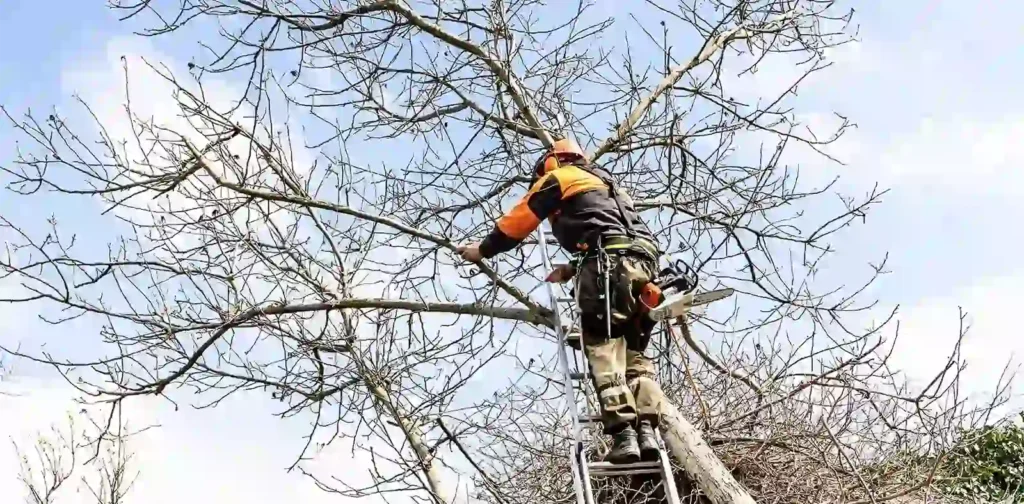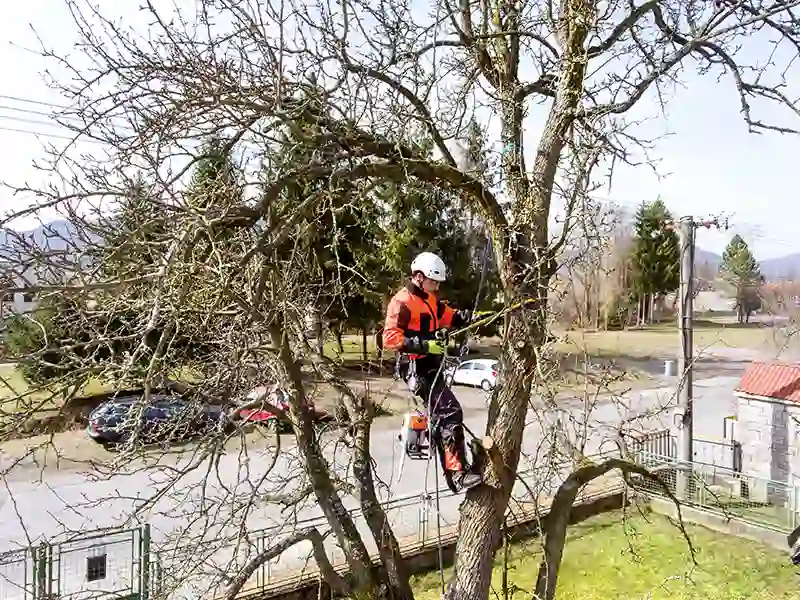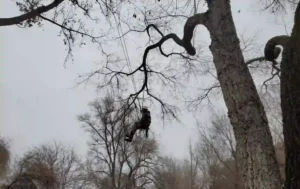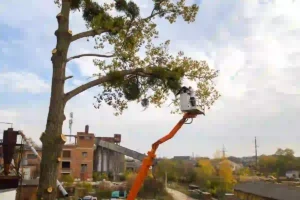Finding tree pruning services in your area means checking for ISA certified arborists, verifying insurance, getting written estimates, and calling local references. Local companies respond faster to emergencies, understand regional pests and diseases, and know local permit requirements better than companies from outside your area.
Pricing depends on tree size and where you live. Small trees under 25 feet run $150-$400. Medium trees (25-50 feet) cost $400-$800. Large trees over 50 feet hit $800-$1,500 or more. Before calling anyone, use treetrimmingcostcalculator.com to get baseline pricing for your specific location and tree situation.
Why Hiring Local Actually Matters
Local tree services know regional tree species. They understand your climate. They’ve dealt with whatever pests and diseases show up in your area year after year. Oak wilt timing varies by region. Emerald ash borer hasn’t spread everywhere yet. Fire blight severity differs dramatically by location. Local arborists already know what matters where you live.
Response time makes a difference after storms. Service from 50 miles away might take days to reach you. Company 10 minutes down the road can show up same day to assess damage and schedule removal of that branch leaning against your house.
Local providers know permitting. Your city might require permits for pruning trees over certain sizes. Nesting season restrictions might apply. Heritage tree protections might exist. Local companies deal with these requirements regularly and know the process.
Travel distance affects cost. Companies driving long distances charge more for fuel, time, transportation. Local services have lower travel overhead. Sometimes they pass savings along. Sometimes they don’t but at least you’re not subsidizing someone’s two-hour drive.
Reputation matters more locally. Local businesses can’t do terrible work and disappear because their reputation affects future business in the community. Company from 100 miles away has less incentive to maintain quality once they leave your area and never expect to work there again.
How to Actually Find Quality Services Nearby
To find tree pruning near me, start with treetrimmingcostcalculator.com. Enter your zip code, tree height, species, accessibility issues. Get realistic baseline pricing for your local market. Then when estimates come in you know if someone’s padding numbers or suspiciously cheap in ways that mean problems.
Search specifically instead of relying on “near me” results. Type “tree pruning” plus your actual city name. Gives more targeted results. Check multiple sources. Google search. Better Business Bureau for your area. Local business directories if they still exist.
Ask neighbors who’ve had tree work done recently. Direct recommendations from people with similar properties provide real information. You can literally walk over and look at the work quality on their trees before hiring anyone.
Check with local garden centers or landscape supply places. They often know reputable tree services operating in the area. Might have business cards or contact info readily available.
Verify licensing for your specific location. Some states require tree service licenses. Some cities require business licenses. Some places have zero requirements. Call local government offices to learn what’s actually required. Then verify companies have proper credentials.
What to Look For
ISA certified arborists on staff. Not just the owner who never touches trees. Actual crew members doing the work. International Society of Arboriculture certification proves real knowledge of tree biology, diseases, proper techniques. Verify certification numbers on ISA website because some companies lie about this.
Current insurance. General liability for property damage. Workers’ compensation for employee injuries. Both policies must be current with adequate limits. Get actual certificates showing policy numbers and expiration dates. Then call the insurance company to confirm coverage is active. Don’t skip verification. Many contractors show expired or fake certificates.
Local references from recent jobs. Ask for three references from work completed in your area within last six months. Recent and local both matter. Old references or references from other regions don’t tell you much. Call those references. Ask specific questions about work quality, reliability, cleanup, whether they’d hire again.
Physical local address. Not just a cell phone. Companies with actual locations have more accountability than operations running from a truck with no fixed business address.
Years operating in your area. Companies working locally for several years have established reputations. Brand new operations or companies just starting to work in your area lack local track records.
Online reviews from local customers. Read Google reviews. Check Nextdoor if people in your area use it. Local Facebook groups sometimes have useful information. Look for patterns across multiple complaints. Everybody gets one or two bad reviews. Dozens of complaints about the same issues means real problems.
What Local Pruning Actually Costs
Small trees under 25 feet typically run $150-$400. Includes removing dead branches, light thinning, basic shaping.
Medium trees (25-50 feet) cost $400-$800 for standard pruning. Goes up if tree needs heavy corrective work, has extensive deadwood, or sits in a tough spot.
Large trees (50-75 feet) hit $800-$1,500. Access problems, proximity to buildings, tree condition all affect final price.
Extra large trees over 75 feet easily reach $1,500-$3,000. Sometimes more. These need specialized equipment like large bucket trucks or extensive climbing and rigging work.
Accessibility changes everything. Tree in backyard with no gate access costs more. Equipment gets hand-carried or brought through narrow side yards. Trees near power lines require special protocols and utility coordination. Trees hanging over buildings need careful rigging to avoid dropping branches through your roof.
Debris removal adds $100-$300 depending on volume. Some services include cleanup and hauling in base price. Others charge separately. Clarify this before work starts not after.
Emergency storm pruning costs 50-100% more than scheduled work. Local services charge premium rates for emergency response. You need immediate help and can’t shop around when a tree is leaning on your house.
Season affects pricing. Winter and early spring typically run 20-30% lower than peak summer season. Local demand drives differences. Schedule non-urgent work during slower seasons for better rates.
Timing for Different Tree Types
Most deciduous trees prune best during dormancy. Late winter or early spring before buds break. Tree is dormant. Disease pressure is lower. Full growing season remains for recovery.
Oak trees in oak wilt regions need specific timing. Prune only during dormancy (usually November through March) when beetles spreading disease are inactive. Local arborists know regional oak wilt risk and proper windows.
Fruit trees need late winter pruning before blooming. Maintains fruiting wood while removing dead or crossing branches. Timing directly affects next season’s fruit production.
Pines and evergreens get pruned late winter or very early spring. Never remove more than one-third of foliage in single year. Pines can’t regenerate from bare wood like deciduous trees can.
Spring-flowering trees like dogwoods or cherries prune right after flowering ends. Prune before flowering and you remove flower buds. Prune after and you preserve next year’s blooms.
Storm damage needs immediate attention regardless of season. Broken or hanging branches create hazards requiring prompt removal.
Dead branches can come out any time. They’re already dead so timing doesn’t matter for tree health. But removal prevents unexpected falling.
Local arborists know regional timing for pest and disease concerns. Emerald ash borer, fire blight, other threats have specific windows for treatments that coordinate with pruning schedules.
Questions to Ask Local Services
How many years have you operated in this area? Established local presence means reputation to maintain and knowledge of local conditions.
Do you have ISA certified arborists on the crew doing actual work? Not in office. On crew. Get certification numbers to verify yourself.
Can you provide proof of current insurance? General liability and workers’ comp. Get certificates and verify with insurance company directly.
What specific pruning method will you use? Crown thinning, crown raising, crown reduction, selective branch removal. Different methods achieve different results.
What’s included in your written estimate? Exact work being performed. Equipment used. Cleanup included or extra. Debris disposal. Timeline for completion.
Can you provide three local references from similar jobs? Trees of similar size and species. Properties with similar access challenges if relevant.
Do you know specific requirements for my tree species? Different species need different approaches. Answer reveals expertise level.
What permits are needed for this work in my area? Professional local companies know requirements and handle applications.
What’s your scheduling timeline? How soon can you start? How long will work take? What happens if weather delays things?
How do you handle unexpected issues discovered during work? Stop and get approval for additional charges? Or make decisions without consulting you first?
Common Mistakes People Make
Hiring based purely on lowest price. Cheap quotes often mean untrained crews, poor technique, no insurance, or hidden charges appearing later. Quality work costs fair market rates. Significantly below-market pricing signals problems coming.
Skipping insurance verification. Taking contractor’s word they’re insured isn’t enough. Get certificates. Verify coverage. Many contractors claim insurance they don’t have or let lapse.
Not getting written estimates. Verbal quotes are worthless for comparison and provide zero recourse if disputes arise. Written detailed estimates are required period.
Hiring door-to-door solicitors after storms. Legitimate established local companies don’t knock on doors. Storm chasers do poor work and disappear. They have no local reputation at risk.
Not checking local references. Collecting phone numbers without actually calling wastes the opportunity to learn about work quality, reliability, professionalism.
Ignoring online reviews. Local reviews reveal patterns. Multiple complaints about same issues show how company operates normally.
Hiring companies from far away to save money. Savings on labor might disappear in higher mobilization costs, slower emergency response, less accountability for quality.
Accepting vague estimates. “Tree pruning – $500” tells you nothing about what work gets performed or what’s excluded.
DIY vs Professional Work
Small ornamental trees under 10 feet might be manageable if you have proper tools and knowledge. Requires understanding correct cuts, timing, tree-specific requirements.
Anything over 15 feet needs professionals. Heights requiring ladders create safety hazards. Falls from ladders kill or seriously injure people every year. Professional equipment and training prevent accidents.
Trees near power lines always require professionals regardless of tree height. Power line contact can electrocute workers and cause outages. Some utilities won’t allow private contractors near high-voltage lines at all.
Trees with disease or pest problems need professional diagnosis before pruning. Wrong timing or technique spreads disease to healthy trees. Professionals know when pruning is contraindicated.
Large branch removal over three inches diameter requires proper technique and equipment. Improper removal tears bark, creates large wounds that won’t heal properly, causes section failures.
Structural pruning to correct growth problems needs expert knowledge. Bad cuts create more problems than they solve. Topping trees to control height creates permanent structural damage instead of solving anything.
Professional work prevents more expensive problems. DIY mistakes often cost more to fix than professional work would have cost initially. Dead trees from improper pruning require expensive removal plus replacement costs.
Getting Most Value from Local Services
Schedule work during off-peak seasons. Winter and early spring offer better availability and lower pricing compared to peak summer demand.
Bundle multiple trees in single visits. Mobilization costs get spread across multiple trees reducing per-tree cost.
Get estimates from at least three local companies. Compare detailed written estimates against treetrimmingcostcalculator.com baseline for your area. Reveals fair market rates and identifies outliers.
Ask about maintenance plans if you have multiple trees. Annual contracts often cost less per visit than individual calls and ensure proper timing for seasonal work.
Build relationships with quality local providers. Trees need regular maintenance. Finding reliable local service creates ongoing value through consistent quality and priority scheduling.
Keep detailed records of all work. Provides history when selling property. Proves proper care to insurance companies. Tracks long-term tree health trends.
Address small problems immediately when identified. Small fixes cost little now. Waiting until problems grow costs significantly more later.
Red Flags Demanding You Walk Away
No physical address. Just cell phone. No website. No online presence. These indicate operations with zero accountability.
Pressure tactics. Price only good today. Other customers waiting for your slot. Pushing for deposits before providing detailed written estimates. Legitimate companies don’t use these approaches.
Can’t or won’t provide insurance certificates. Immediate disqualification. Zero exceptions ever.
No local references. Or provides only first names without contact information. Companies with good local reputations provide references readily.
Reluctance answering questions about experience, certifications, methods. Professional companies welcome questions and provide detailed answers.
Quotes dramatically below baseline from treetrimmingcostcalculator.com. Means corners getting cut somewhere dangerous.
Doesn’t ask about tree species, health status, timing considerations. Treating all trees same reveals lack of expertise.
Finding quality local tree pruning requires research and verification. Use treetrimmingcostcalculator.com to understand fair pricing where you live. Verify insurance and certifications yourself. Check local references by actually calling them. Get detailed written estimates from multiple companies. Choose based on qualifications, local reputation, and fair pricing instead of lowest bid. Professional local pruning protects valuable property assets, prevents expensive emergencies, and maintains trees properly for long-term health and safety.




